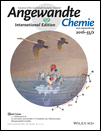Hydrogen Bond Fluctuations Control Photochromism in a Reversibly Photo-Switchable Fluorescent Protein
Graphical Abstract
What's going on in Dronpa? Computational simulations reveal that structural heterogeneity divides the ground state ensemble of reversibly photo-switchable fluorescent proteins into two populations, of which the major one fluoresces upon photon absorption, whereas the minor population deactivates into a dark non-fluorescent state.
Abstract
Reversibly switchable fluorescent proteins (RSFPs) are essential for high-resolution microscopy of biological samples, but the reason why these proteins are photochromic is still poorly understood. To address this problem, we performed molecular dynamics simulations of the fast switching Met159Thr mutant of the RSFP Dronpa. Our simulations revealed a ground state structural heterogeneity in the chromophore pocket that consists of three populations with one, two, or three hydrogen bonds to the phenolate moiety of the chromophore. By means of non-adiabatic quantum mechanics/molecular dynamics simulations, we demonstrated that the subpopulation with a single hydrogen bond is responsible for off-switching through photo-isomerization of the chromophore, whereas two or more hydrogen bonds inhibit the isomerization and promote fluorescence instead. While rational design of new RSFPs has so far focused on structure alone, our results suggest that structural heterogeneity must be considered as well.





